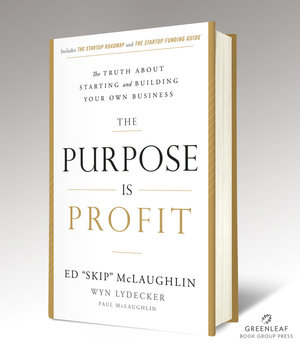
By Ed McLaughlin
Previously Published in FORTUNE
Questions every entrepreneur should ask when thinking about sales, pricing and production.
The following is an excerpt from Ed McLaughlin and Wyn Lydecker’s new book The Purpose Is Profit (Greenleaf Book Group Press, 2016), which recounts how, after quitting his high-level corporate job, McLaughlin started a thriving business that was eventually acquired by a Fortune 100 company. A serial entrepreneur, McLaughlin is the founder and CEO of Blue Sunsets, a real estate and investment firm based in Darien, Connecticut.
A key step in developing your revenue model is determining the types and sources of revenue your business will generate. Revenue types include product sales, service fees, advertising sales, data access fees, license fees, and/or commissions.
Each type of revenue generated can come from a multitude of sources. For example, sources of revenue from service sales can vary depending on customer type and category, including online, mobile, consumer, corporate, institutional, and/or government. Additionally, each category can expand into multiple sources. For example, the corporate sales category can include major accounts, named accounts, vertical markets, geographic territories, partnerships, and one-off sales.
My business had a pretty simple revenue model. We sold real estate portfolio management and transaction management services to corporations. Our customers paid us fees for dedicated resources and commissions on transactions. As the business evolved and our service lines expanded, we developed a more complex fee structure suited to the types of services our customers consumed.
How will you structure your revenue model?
— Will you collect sales revenue directly from customers in exchange for the service or product?
— Will your business act as an intermediary, helping to bring buyers and sellers together and collecting a fee for the service or a commission on the resulting sale?
— Will your business be a publisher of content or the creator of an online community that charges for access to the content or community?
— Will you provide content or community for free and collect revenues from advertisers who want to target your readers or users?
— Will you give permission for your product to be used in exchange for a license fee?
— Will you be a collector of data and charge fees to marketers for access to that information?
— Will your business use a combination of these revenue models?
Determining the types and sources of revenue your business will generate is the first step toward realizing a profit.
Product pricing: What will you charge for your product?
Determine your price by selecting your revenue model while factoring in your competitive positioning and your ideal profit target. Each type of revenue model will most likely have market benchmarks you can research to help you price competitively.
From my previous corporate sales experience, I had a firm understanding of traditional pricing models for real estate services. By aggregating portfolio and transaction services through a single source, I knew I could cover my costs and beat the competition with aggressive volume-based pricing. If you know your industry, you may be able to do the same.
Consider the following questions:
— Will you be developing a radical new pricing model?
— Will your price be aligned with traditional benchmarks?
— Will your price be competitive?
— Will you be selling a premium product, enabling you to charge more than your competitors, or will you undercut the competition?
— Should you use a simple markup to cover your unit costs?
— If you are a content provider, what are the prevailing rates for the type of advertising you are selling?
— If you are a provider of data, what do marketers typically pay for access to similar information?
— Will your price cover your cost and leave room for a reasonable profit?
Once you can explain the basic revenue model and your pricing, you can estimate how many customers you expect to have, how many sales you’ll likely make to each one, and how often you will make those sales—daily, weekly, monthly, or annually. Taken together, this information will enable you to project your total revenue.
Production and distribution: What will it take to create, manufacture, and deliver your product to your customers?
For a manufactured product, you will need to think through and quantify your requirements for raw materials, labor, machinery, inventory, and distribution. For a service business, you will need to quantify your service fulfillment costs including staffing, travel costs, response times, and performance reporting.
Since my business was a service business, we were concerned about sales and service delivery costs. Beyond the production of proposals and due-diligence binders, we did not have a manufacturing cost. The key components of our product were account management, data management, market knowledge, and negotiation skills. My company’s expenses were very similar to a traditional consulting business, with most of our employees situated on-site at our customers’ headquarters.
On the other hand, a manufacturing and distribution business has a more significant challenge in accurately estimating production costs. It will be important to develop a thorough production cost model to ensure you have considered all of the major costs.
Some of the factors you will need to address to estimate production costs include the following:
— Prototype costs
— How will you create a prototype or samples to help you secure preorders?
— How much will it cost to create a prototype or sample products?
— Production costs
— Quantify the type, amount, and source of materials, labor, and equipment needed to manufacture your product.
— Generate a preliminary estimate of costs for materials, labor, and/or equipment needed for your product.
— Determine whether you will make your product or outsource its production.
If you make your product,
— What are your raw material costs?
— What are your labor costs?
— What are your equipment costs?
— What are your facilities costs?
— What are your distribution costs?
— How long will it take to manufacture your product?
— What is the total unit production cost of your product?
— If you outsource, who will make your product, how much will it cost, and how long will it take?
Finalize the make vs. buy decision by weighing the quantitative and qualitative benefits of each.
Determining accurate production costs and time frames for a manufacturing business is critical to the development of a profitable and reliable business model. Please keep in mind that this is merely a high-level outline designed to get you started.
Ed McLaughlin is the author of The Purpose Is Profit: The Truth about Starting and Building Your Own Business, along with co-authors Wyn Lydecker and Paul McLaughlin. The Purpose Is Profit (Greenleaf Book Group) is available in bookstores now.

Order The Purpose Is Profit here.
Copyright © 2016 by Ed McLaughlin All rights reserved.




Leave A Comment